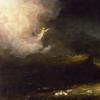$15M Chinese Vase To Close Asia Week Auctions
- NEW YORK, New York
- /
- March 16, 2016
On Saturday, March 19th Asian art collectors will gather at Gianguan Auctions to watch a Qing Dynasty vase valued at up to $15,000,000 turn the heads of collectors. It will be followed by the presentation of a "Chess Game abut of Screen," by Five Dynasties court painter Zhou Wenju (942-961) that may be the original of one by the same name that hangs in China's Forbidden Palace
The vase, Lot 155, is a porcelain masterwork of famille rose enameling and sgraffito - literally, scratching the hard fired surface to tap the hue of a glaze or slip beneath. An abundance of precisely executed peonies and butterflies set beneath ruyi heads, floral scrolls and a gilt rim stand out on the sgraffito brocade-like background. Of the period, with the Qianlong six-character mark, it is likely to soar into the millions.
The cultural phenomenon of showing respect via imitation accounts for much of the mystery surrounding Lot 92, “Chess Game abut Screen”, attributed to Zhou Wenju, a Five Dynasty’s painter. A similar painting in the Palace Museum is considered a National Treasure although experts feel it might be a copy made by Song Emperor Zhou. New evidence indicates the painting on view at Gianguan Auctions may be the long lost original. Estimate on the painting has not been made public. For details, please contact the auction gallery.
Leading the Chinese paintings is Lot 78, ‘Five Cattle” by Yan Ciping of the Southern Song Dynasty. The period was one of heightened appreciation for art. Fine paintings often inspired others to copy them, as is the case with this painting which is after Han Huang’s earlier “Five Cattle”. It will command as much as $5,000,000.
Meanwhile, Lots 85-88 are the epitome of quiet rebellion. They are paintings created by Bada Shanren, a Ming citizen turned monk. The four images are leaves of an album. Each depicts a lone animal in a nuanced scene that reflects the artist’s disdain for the Qing rulers. Bidding on each starts at $250,000.
Another series of painting, Lot 98, The Four Seasons by Li Keran, are notable. A set of four detailed landscapes take the viewer into China’s magnificent countryside to view the features that are emphasized during each change of the year. Calligraphy from the same hand adds to the flavor. The series is valued at $40,000-$60,000
Happiness, harmony, longevity, prosperity, the universal themes the Chinese portray so well, live in the collection of paintings of mynah birds, eagles, monkeys, and horses positioned throughout the auction. Values range from $6,000 for Lot 73, Gao Jianfu’s “Eagle and Maple” to $30,000 or more for Lot 111, Zhao Shaoang’s “Birds and Sunflowers.”
Calligraphy works have their own story to tell. Lot 74, “Script Calligraphy,” by Liu Yung , and Lot 79, “Emperor Daoguang’s Calligraphy,” 1828, signed by the Emperor and bearing two artist seals, anchor the collection at $6,000-$8,000. Lot 91, Dong Quchang’s 17th century “Script Calligraphy,” is representative of mid-level works. Its estimate tops off at $80,000.
Decorative antique and modern works of art populate the rest of the auction. For instance, from the Yongzheng period (1723-1735) - when the best famille rose ceramics were produced - comes Lot 193. It is a wine cup depicting Luohans riding on undulating clouds with bats in flight above them. The figurative decoration is rare in the genre dominated by florals. The Yongzheng four-character mark with double circles authenticates the period. The 2 1/4 inch cup is $50,000-$80,000.
A group of 18th century Korean ceramics, Lots 225-228, also provide insight into design perspectives of the past. Three vases, spare of line, and a teapot decorated with abstract flower pods are highly collectible at $300-$500 each.
A court necklace of large amber beads, Han painted glass, Tibetan eye beads, and coral leads the items of personal adornment. It is Lot 162, defined by five pendants shooting off an amber bead collar. The very-wearable court necklace is expected to bring as much as $15,000.
Another amber star lot is Lot 222, a phoenix formed ewer with matching cups, all of golden honey hue. The ewer, surmounted with a Buddhist mandorla and sporting a tail shaped handle, sits on an eight-lobed saucer. Its cups are all carved as phoenix with ruyi tails. The low estimate is $8,000.
China's natural history accounts for the crystalized bursts in scholars rocks. Lot 52, features a brilliant crystalized chrysanthemum. Mounted on a wooden base, the 8 inch stone is $2,000-$3,000. Lot 55 is a double calcite chrysanthemum formation in a stone decorated with carvings. It is similar to a stone flower screen in the Hunan Provincial Museum. Bidding starts at $2,000.
Haitian white jade defines a collection of snuff bottles and small figural carvings early in the sale. Lot 50 is a white jade carving of three rams, an auspicious sign. Its estimate is upwards of $4,000. Contrasting this is Lot 51, a deep spinach green recumbent horse with monkey signifying prosperity. It starts at $2,000.
Finally, Lot 194 a root stand of highly polished boxwood will enliven any collection with its naturalistic beauty. An intertwined and irregular top stands on a gnarled base, Thirty-three inches tall and weighing thirsty pounds, the stand will go for more than $3,000.
The auction on March 19 at Gianguan Auctions will be conducted live in the gallery at 39 W. 56th Street and online at invaluable.com. For details on these and other properties in the auction, please visit the online catalog at http://www.gianguanauctions.com

270x400_c.jpg)















![Peter Paul Rubens (Flemish, 1577–1640), After Titian (Tiziano Vecelli) (Italian [Venetian], c. 1488–1576), Rape of Europa, 1628–29. Oil on canvas, 71 7/8 x 79 3/8 in. Peter Paul Rubens (Flemish, 1577–1640), After Titian (Tiziano Vecelli) (Italian [Venetian], c. 1488–1576), Rape of Europa, 1628–29. Oil on canvas, 71 7/8 x 79 3/8 in.](/images/c/e2/2e/Jan20_Rape_of_Europa100x100_c.jpg)
